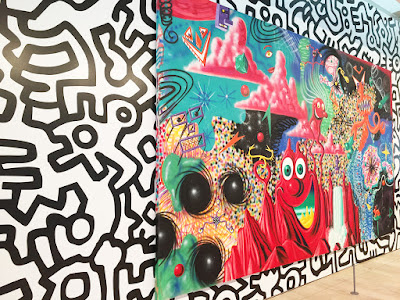Whitney Museum
Renzo Piano, Architect
We approach the Whitney Museum from the west. It is a bright, sunny afternoon in New York City and it has been snowing earlier in the week, so we had a brilliant day to drive downtown and park to look around. The new Whitney has many fine points and the architect, Renzo Piano is to be commended: he envisioned interesting spaces inside the museum and many balconies facing east outside. We take the elevator to the eighth floor for a show called "Fast Forward" - Paintings from the 1980's. I was there then, going to shows and hearing from the artists, and the early 1980's re-established the importance of painting - there was a short lived boom for the art form. You get a taste for that - stepping out of the elevator to confront Kenny Scharf and Keith Haring in a kind of visual exhortation.
Keith Haring ( 1958-1990 ) ( wallpaper ) and Kenny Scharf ( painting )
So you see a bit of the transgressive behavior of Haring ( defacing subway walls ) most of which is long forgotten, and with Kenny Scharf you get an artist from the 1980's looking back to kid's cartoons and other bizarre mark making .
Painting by Leon Golub ( 1922-2004 )
In "Fast Forward" one of the strongest paintings is by Leon Golub which could have been made yesterday - the subject is so present - the power structures of brutality ( wherever it occurs )
- rendered in a style that has a ground-down look because that is what it is.
Painting by David Salle
The irony of juxtaposition is on view in the painting by David Salle that commandeers the magazine layout ethos but drops the easy story in favor of a more obscure symbolic tale told by comparison.
The 1980's also saw the rise of painting by Julian Schnabel where often ceramic dinner plates were adhered to a canvas using Bondo. One of my early students from R.I.T. was there working with Julian in his studio doing the daily tasks which also included baby-sitting. Julian's painting on velvet at the Whitney isn't quite as interesting as some of his films - including a movie about Jean-Michel Basquiat who is also represented in "Fast Forward". We stopped to admire a canvas by Terry Winters before we head downstairs.
Terry Winters in "Fast Forward"
at the Whitney
Going down to the next floor via an outside stairway you come across beautiful views north and south, and an odd sculpture set atop some poles that looks like a sideways ear of corn with large nails attached and a head with a hole in it. The label says this work is by an artist cooperative perhaps from the Middle East and their sculpture has the enigmatic title: "Local Police Find Fruit With Spells, 2017".
"Local Police Find Fruit With Spells, 2017"
We then walk around a floor of the new Whitney devoted to portraits from the museum's collection and I stop by a painting by Beauford Delaney ( 1901-1979 ) that I think I have seen before in Michael Rosenfeld's Gallery. My cousin, Michael, is a strong supporter of art by African-Americans and I am glad to see that this work is included in the present show called "Human Interest" that runs through April 2nd, 2017.
Auto-Portrait 1965, oil on canvas
Painting by Beauford Delaney
On floors five and six we find the main attraction, the Whitney Biennial, and since it is the first day, the show is packed with visitors and this exhibition is an exercise in sensory overload. If you get off the elevator, you might be greeted by the sight of Dana Schutz's painting called "Elevator", and it is a wonderful work that is part cubist, part figurative, and part Krazy Kat.
Dana Schutz with her painting called "Elevator"
The curators for the Biennial express their point of view through the artwork they have chosen, and they attempt to tackle subjects like inequality, neighborhood politics, student debt, and other life and death matters.
Biennial Curators
Mia Locks and Christopher Lew
from a photo by Pari Dukovic
In my next post I will try to get in close to take a look at some of the featured works in the Biennial so stay tuned...









